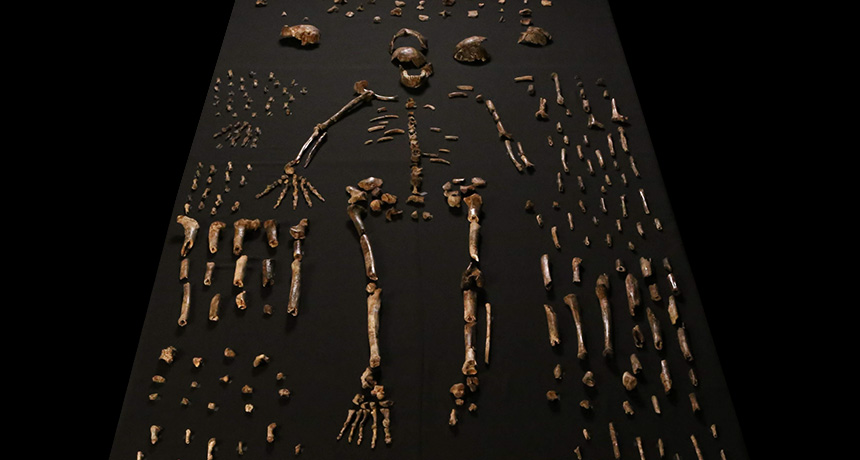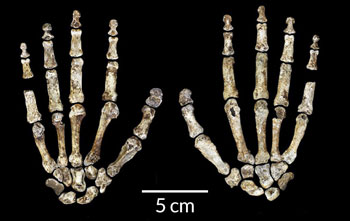Fossils: Is this new species a human relative?
Skinny cavers were needed to find bones deep in a South African cave

An array of hominid fossils from a South African cave shows many body parts of the newly identified species Homo naledi. The partial skeleton in the center consists of bones from several individuals.
L.R. BERGER ET AL/ELIFE 2015 (CC BY 4.0)
Share this:
- Share via email (Opens in new window) Email
- Click to share on Facebook (Opens in new window) Facebook
- Click to share on X (Opens in new window) X
- Click to share on Pinterest (Opens in new window) Pinterest
- Click to share on Reddit (Opens in new window) Reddit
- Share to Google Classroom (Opens in new window) Google Classroom
- Click to print (Opens in new window) Print
By Bruce Bower
Fossils found in an underground cave in South Africa may be from a previously unknown species of the human genus, Homo.
The fossils come from at least 15 individuals. They were pulled from a pit 30 meters (100 feet) deep. Lee Berger led the team of excavators. He works at the University of the Witwatersrand in Johannesburg, South Africa. His team reported details of its find September 10 in the journal eLife.
The skeletal remains display a mix of traits. They are unlike anything researchers had seen before. The bones and teeth have some features that are similar to humans. But the fossils also have some apelike qualities. The same traits are seen in 2-million- to 4-million-year-old fossils that belong to Australopithecus (Aw-STRAL-oh-PITH-eh-kus). It’s an extinct genus that is a close relative to the genus Homo.
As a paleoanthropologist, Berger studies fossils and cultural clues left behind by ancient humans and their relatives. The fossils his team has just recovered come from a new species. They’ve named it Homo naledi. The word naledi means star in South Africa’s Sotho language. “We don’t know how old these fossils are,” Berger said September 9 during a news conference. “But based on its anatomy, H. naledi clearly sits near or at the root of the Homo genus.” By anatomy, he means the shape and arrangement of body parts.
Remains of the new hominid were recovered in November 2013 and March 2014. That was shortly after two cave explorers discovered the fossils and alerted Berger. The fossils sat in a pit now nicknamed Dinaledi Chamber. But Berger and most researchers were too big to get to it. That’s because it sits at the end of a narrow hole 90 meters (300 feet) deep. So Berger’s team recruited six slender researchers who also were experienced cave explorers. They eventually found 1,550 H. naledi fossils on the cave floor and buried in the soil.
Berger’s team doesn’t yet know how old any of the bones are. The fossils lay in soft sediments that have partly mixed together over time. That means the researchers can’t know the bones’ original location. If they did know that, it could have helped the team determine their age. Nor were fossils of other animals found near the hominid remains. That deprived researchers of another clue to H. naledi’s age.
Without knowing how old the bones are, some researchers are skeptical about the find. Without those dates, it remains unknown how important the discovery is for understanding the human family tree, says Carol Ward. She, too, is a paleoanthropologist. She works at the University of Missouri in Columbia.
If the fossils date to more than 2 million years ago, though, H. naledi would become one of the oldest members of the human genus. A date younger than 2 million years would support the idea that many Homo species once coexisted in Africa. They would have lived at the same time as many Australopithecus species.
Berger and his colleagues estimate that H. naledi stood an average of about 1.5 meters (5 feet) tall. Adults would have weighed around 45 kilograms (almost 100 pounds).

In contrast, H. naledi’s shoulder, rib cage, pelvis, upper leg and curved fingers should have enabled it to climb trees well, the investigators say. That is something seen in Australopithecus species. H. naledi also had an Australopithecus-sized brain. That means it was about the size of an orange.
Opinions about the finds vary among paleoanthropologists. For instance, “Despite the small brain, this new species is clearly part of the genus Homo because of the way the skull is built,” says Fred Spoor. He works at University College London. Still, he doubts H. naledi was a direct ancestor of modern humans.
Christoph Zollikofer agrees that the fossils probably belong in the Homo genus. But this University of Zurich scientist thinks the bones look “strikingly similar” to nearly 1.8-million-year-old Homo erectus fossils found in West Asia. So he wonders whether the South African hominids may have belonged to H. erectus. While living at the bottom of the continent, they might simply have evolved a few skeletal innovations, such as distinctive hands, he suggests.
Yet Susan Antón of New York University is not so sure. Australopithecus-like features of the teeth and lower body raise doubts in her about whether the new finds come from an early Homo species at all. So she finds the fossils “fabulous and a bit confusing.”
In another analysis likely to cause scientific debate, Berger’s group suggests that H. naledi intentionally dropped dead comrades down the hole, perhaps in some type of ritual. Those findings are described September 10 in a second eLife paper. In it, a team led by geologist Paul Dirks of James Cook University in Townsville, Australia, described examining the fossils and the soil in which they were found. That analysis helped them rule out some other explanations for the hominids’ presence in the cave. They determined that the bones had not been washed in by floods or dragged in by predators.
The possibility that H. naledi deliberately disposed of bodies in the cave is “interesting and intriguing, but will also be controversial,” Spoor says.
Power Words
(for more about Power Words, click here)
anatomy (adj. anatomical) The study of the organs and tissues of animals. Or the characterization of the body or parts of the body on the basis of its structure and tissues. Scientists who work in this field are known as anatomists.
ape A group of rather large “Old World” primates that lack a tail. They include the gorilla, chimpanzees, bonobos, orangutans and gibbons.
Australopithecus An extinct genus of hominids that lived in east Africa from about 4 million to 2 million years ago.
coexist To exist at the same time as or along with.
continent (in geology) The huge land masses that sit upon tectonic plates. In modern times, there are six geologic continents: North America, South America, Eurasia, Africa, Australia and Antarctica.
culture (in social science) The sum total of typical behaviors and social practices of a related group of people (such as a tribe or nation). Their culture includes their beliefs, values, and the symbols that they accept and or use. It’s passed on from generation to generation through learning.
excavation The process of systematically removing earth from a site to uncover buried remains, such as bones or artifacts.
fossil Any preserved remains or traces of ancient life. There are many different types of fossils: The bones and other body parts of dinosaurs are called “body fossils.” Things like footprints are called “trace fossils.” Even specimens of dinosaur poop are fossils. The process of forming fossils is called fossilization.
gait The pattern of leg motions by which an animal walks from place to place.
geology The study of Earth’s physical structure and substance, its history and the processes that act on it. People who work in this field are known as geologists. Planetary geology is the science of studying the same things about other planets.
genus (plural: genera) A group of closely related species. For example, the genus Canis — which is Latin for “dog” — includes all domestic breeds of dog and their closest wild relatives, including wolves, coyotes, jackals and dingoes.
hominid A primate of an animal family that includes humans and their fossil ancestors.
Homo A genus of species that includes modern humans (Homo sapiens). All had large brains and used tools. This genus is believed to have first evolved in Africa and over time its members continued to evolve and radiate throughout the rest of the world.
Homo erectus An extinct species of hominid that lived in Africa and Eurasia from about 1.9 million to 70,000 years ago.
Homo naledi An extinct human relative of unknown age. The bones of this species were found in a cave in South Africa in 2013 and 2014.
paleoanthropology The study of the culture of ancient people or human-like folk, based on the analysis of remnants, artifacts or markings created or used by these individuals. People who work in this field are known as paleoanthropologists.
predator (adjective: predatory) A creature that preys on other animals for most or all of its food.
sediment Material (such as stones and sand) deposited by water, wind or glaciers.
species A group of similar organisms capable of producing offspring that can survive and reproduce.
vertical A term for the direction of a line or plane that runs up and down (as the vertical post for a streetlight does). It’s the opposite of horizontal, which would run parallel to the ground.







